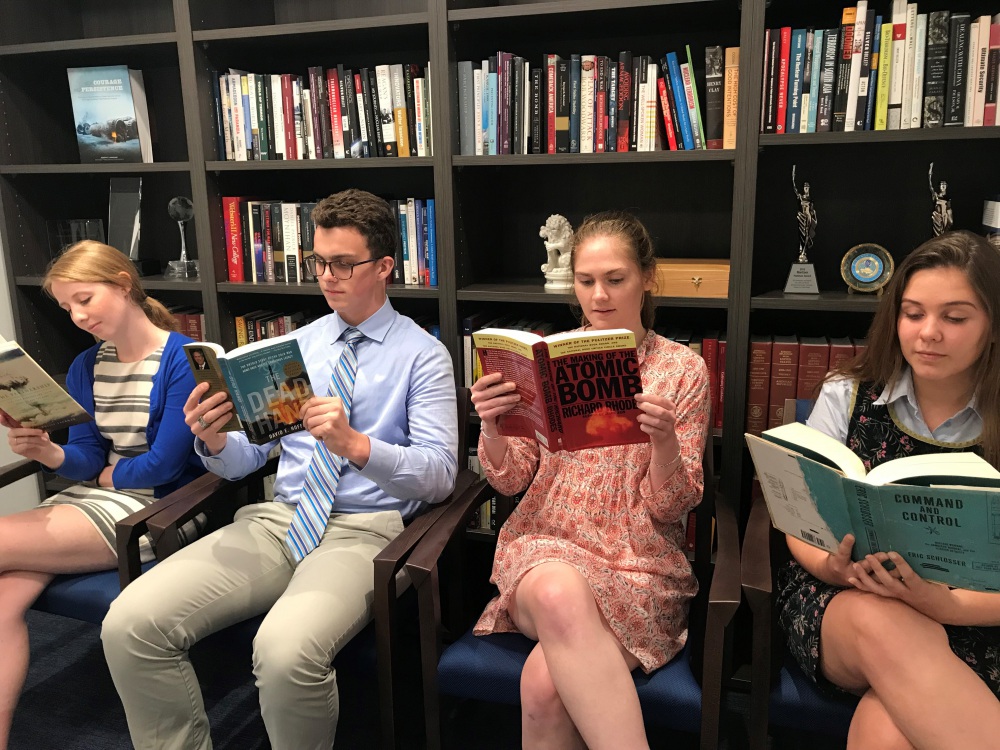Need a good beach read? We admit this isn’t exactly a light reading list, but our 2018 class of interns asked for essential reading, and we pulled together the suggestions below. We thought we’d share them with you!
So whether you’re taking a day at the shore, going on vacation, or just having a lazy afternoon, grab one or more of these great books and brush up on the current debates in nuclear policy, nonproliferation and deterrence, learn about cutting edge research in biosecurity, or discover new dangers in cyberspace.
In case you need a break as you plow through the list, we’ve included some of our favorite movies and podcasts!
Thanks to Mary Fulham, an intern on NTI’s Global Nuclear Policy and Programs team, who compiled this list after reading every entry (just kidding – but she’s working on it!). Mary is a recent graduate of The George Washington University’s Elliott School of International Affairs with a major in Middle East Studies.
Deterrence Theory and Early Development and Use of WMDs
- Richard Rhodes, The Making of the Atomic Bomb (Simon & Schuster, 1995).
- Herman Kahn, On Thermonuclear War (Princeton University Press, 1960).
- Robert Zarate and Henry Sokolski eds., Nuclear Heuristics: Selected Writings of Albert & Roberta Wohlstetter (Strategic Studies Institute, 2009).
- The Acheson-Lilienthal Report, 1946. https://www.learnworld.com/ZNW/LWText.Acheson-Lilienthal.html.
- John Hersey, Hiroshima (Vintage, 1989).
- Albert Einstein’s letter to President Franklin Delano Roosevelt, 1939. https://www.atomicarchive.com/Docs/Begin/Einstein.shtml.
- Jeffrey Lewis, “Minimum Deterrence,” Bulletin of the Atomic Scientists (July-August 2008): 38-41.
- Howard Morland, “The H Bomb Secret: To Know How is to Ask Why,” The Progressive (November 1979).
Cold War History
- William J. Perry, My Journey at the Nuclear Brink (Stanford Security Studies, 2015).
- John Lewis Gaddis, The Cold War: A New History (Penguin Books, 2006).
- David Hoffman, The Dead Hand: The Untold Story of the Cold War Arms Race and Its Dangerous Legacy (Anchor, 2010).
- Garrett Graff, Raven Rock: The Story of the U.S. Government’s Secret Plan to Save Itself—While the Rest of Us Die (Simon & Schuster, 2017).
- Lynn Eden, Whole World on Fire: Organizations Knowledge, and Nuclear Weapons Devastation (Cornell University Press, 2004).
- Spencer Weart, Nuclear Fear: A History of Images (Harvard University Press, 1989).
- McGeorge Bundy, “To Cap the Volcano,” Foreign Affairs (October 1969).
- Contemporary U.S. Nuclear Strategy, Policy, and Budget
- Brad Roberts, The Case for U.S. Nuclear Weapons in the 21st Century (Stanford Security Studies, 2015).
- Richard A. Muller, Physics for Future Presidents: The Science Behind the Headlines (W.W. Horton & Company, 2009).
- Stephen M. Younger, The Bomb: A New History (Harper Collins, 2009).
- Douglas Waller, Big Red: Three Months on Board a Trident Nuclear Submarine (Harper Collins, 2001).
- Phillip Taubman, The Partnership: Five Cold Warriors and Their Quest to Ban the Bomb (Harper Collins, 2012).
Government Publications
- Department of Defense, Nuclear Posture Review, February 2018, https://media.defense.gov/2018/Feb/02/2001872886/-1/-1/1/2018-NUCLEAR-POSTURE-REVIEW-FINAL-REPORT.PDF.
- Department of Defense, Nuclear Posture Review, April 2010, https://www.defense.gov/Portals/1/features/defenseReviews/NPR/2010_Nuclear_Posture_Review_Report.pdf.
- White House, National Security Strategy of the United States of America, December 2017, https://www.whitehouse.gov/wp-content/uploads/2017/12/NSS-Final-12-18-2017-0905.pdf.
- Department of Defense, Summary of the 2018 National Defense Strategy of the United States of America: Sharpening the American Military’s Competitive Edge, https://www.defense.gov/Portals/1/Documents/pubs/2018-National-Defense-Strategy-Summary.pdf.
- Department of Defense, The Nuclear Matters Handbook: Expanded Edition, 2016, https://www.acq.osd.mil/ncbdp/nm/nmhb/chapters/chapter_1.htm.
- Congressional Budget Office, Approaches for Managing the costs of U.S. Nuclear Forces, 2017 to 2046, https://www.cbo.gov/system/files/115th-congress-2017-2018/reports/53211-nuclearforces.pdf.
Accidental Nuclear War and Nuclear Security
- Eric Schlosser, Command and Control: Nuclear Weapons, the Damascus Accident, and the Illusion of Safety (Penguin Books, 2014).
- Bruce G. Blair, The Logic of Accidental Nuclear War (Brookings Institution Press, 1993).
- Scott Sagan, The Limits of Safety: Organizations, Accidents, and Nuclear Weapons (NJ: Princeton, 1993).
- Daniel Ellsberg, The Doomsday Machine: Confessions of a Nuclear War Planner (Bloomsbury USA, 2017).
- George P. Shultz, Sidney D. Drell, Henry A. Kissinger, Sam Nunn, Nuclear Security: The Problems and the Road Ahead (Hoover Institution Press, 2014).
Proliferation and Decision-making
- Scott D. Sagan and Kenneth N. Waltz, The Spread of Nuclear Weapons: An Enduring Debate (W. W. Norton & Company, 2012).
- Scott D. Sagan, “Why Do States Build Nuclear Weapons: Three Models in Search of a Bomb,” in Michael E. Brown, Owen R. Cote Jr., Sean M. Lynn- Jones, and Steven E. Miller eds., Going Nuclear: Nuclear Proliferation and International Security in the 21st Century (MIT Press, 2010): 3-25.
- Robert Jervis, Perception and Misperception in International Politics (NJ: Princeton, 1976).
- Stephen I. Schwartz, Atomic Audit: The Costs and Consequences of U.S. Nuclear Weapons Since 1940 (Brookings Institution Press, 1998).
- Alain C. Enthoven and K. Wayne Smith, How Much is Enough? Shaping the Defense Program, 1961-1969 (Harper & Row, 1971). https://www.rand.org/content/dam/rand/pubs/commercial_books/2010/RAND_CB403.pdf.
- Peter Hennessey, The Secret State: Preparing for the Worst, 1945-2010 (Penguin, 2010).
- William Potter and Gaukhar Mukhatzhanova eds., Forecasting Nuclear Proliferation in the 21st Century: Volume 1. The Role of Theory, (Stanford University Press, 2010).
- W.J. Frank ed., Summary of the Nth country Experiment (Lawrence Radiation Laboratory, University of California, Livermore, 1967). Unclassified, redacted version: https://www.gwu.edu/~nsarchiv/news/20030701/nth-country.pdf.
- Peter D. Zimmerman, “Proliferation: Bronze Medal Technology is Enough,” Orbis, Vol. 38, No. 1 (Winter 1994): 67-82.
- Christopher F. Chyba, Chaim Braun, and George Bunn, “Proliferation Rings: New Challenges to the Nonproliferation Regime,” in Michael E. Brown, Owen R. Coté Jr., Sean M. Lynn-Jones, and Steven E. Miller eds., Going Nuclear: Nuclear Proliferation and International Security in the 21st Century (MIT Press, 2010): 368-412.
- Jaswant Singh, “Against Nuclear Apartheid,” Foreign Affairs (September/October 1998).
- Vipin Narang, “Strategies of Nuclear Proliferation: How States Pursue the Bomb,” International Security Vol. 41, No. 3 (Winter 2016-17).
- Etel Solingen, ed., Sanctions, Statecraft, and Nuclear Proliferation (Cambridge University Press, 2012).
Cooperative Threat Reduction
- Graham Allison et al, Avoiding Nuclear Anarchy: Containing the Threat of Loose Russian Nuclear Weapons and Fissile Material (Cambridge: MIT, 1996).
- John Shields and William Potter (eds), Dismantling the Cold War: U.S. and NIS Perspectives on the Nunn-Lugar Cooperative Threat Reduction Program (Cambridge: MIT, 1997).
- National Academy of Sciences, Global Security Engagement: A New Model for Cooperative Threat Reduction (National Academies Press, 2009).
Nuclear Fuel Cycle
- Richard Garwin and Georges Charpak, Megawatts and Megatons: A Turning Point in the Nuclear Age? (New York: Alfred A. Knopf, 2001).
- Kelsey Hartigan, Corey Hinderstein, Andrew Newman, Sharon Squassoni, A New Approach to the Nuclear Fuel Cycle: Best Practices for Security, Nonproliferation, and Sustainable Nuclear Energy (Center for Strategic and International Studies and the Nuclear Threat Initiative, 2015). https://csis-prod.s3.amazonaws.com/s3fs-public/legacy_files/files/publication/150215_Squassoni_NuclearFuelCycle.pdf.
Materials Security
- Tom Zoellner, Uranium: War, Energy, and the Rock That Shaped the World (Penguin, 2010).
- Kristen Iversen, Full Body Burden: Growing Up in the Nuclear Shadow of Rocky Flats (Crown Publishers, 2012).
- Kate Brown, Plutopia: Nuclear Families, Atomic Cities, and the Great Soviet and American Plutonium Disasters (Oxford University Press, 2015).
- Lisa Martino-Taylor, Behind the Fog: How the U.S. Cold War Radiological Weapons Program Exposed Innocent Americans (Routledge, 2017).
- James Doyle, “Introduction: Nuclear Security in the Twenty-first Century” in James Doyle ed., Nuclear Safeguards, Security, and Nonproliferation: Achieving Security with Technology and Policy (Elsevier, 2008).
- Siegfried Hecker, “Why we need a Comprehensive Safeguards System to keep Fissile Material out of the Hands of Terrorists,” in James Doyle ed., Nuclear Safeguards, Security, and Nonproliferation: Achieving Security with Technology and Policy (Elsevier, 2008).
Nuclear Waste
- Blue Ribbon Commission on America’s Nuclear Future, Report to the Secretary of Energy, January 26, 2012. https://cybercemetery.unt.edu/archive/brc/20120620220235/https://brc.gov/sites/default/files/documents/brc_finalreport_jan2012.pdf.
- J. Samuel Walker, The Road to Yucca Mountain: The Development of Radioactive Waste Policy in the United States (Berkeley: Cal, 2009).
- United States Nuclear Waste Technical Review Board, Designing a Process for Selecting a Site for a Deep-Mined, Geologic Repository for High-Level Radioactive Waste and Spent Nuclear Fuel, Report to the United States Congress and the Secretary of Energy (November 2015). https://www.nwtrb.gov/docs/default-source/reports/siting_report_summary.pdf?sfvrsn=3.
Verification
- Innovating Verification: New Tools & New Actors to Reduce Nuclear Risks, NTI, July 16, 2014. The four reports can be found at:
2. International Partnership for Nuclear Disarmament Verification, https://www.ipndv.org/
3. Henry Kissinger, “Arms Control, Inspection, and Surprise Attack,” Foreign Affairs (July 1960).
Nuclear Terrorism
- Graham Allison, Nuclear Terrorism: The Ultimate Preventable Catastrophe (Holt Paperbacks, 2005).
- Paul R. Pillar, Terrorism and U.S. Foreign Policy (Brookings Institution Press, 2001).
- E.U. Condon, “The New Technique of Private War,” in Dexter Masters and Katharine Way eds., One World or None (New York Press, 2007): 107-115.
- National Intelligence Estimate 11-7-63, Director of Central Intelligence, “The Clandestine Introduction of Weapons of Mass Destruction into the U.S,” March 13, 1963. https://www.gwu.edu/~nsarchiv/coldwar/documents/episode-12/05-01.htm.
- Matthew Bunn, Martin Malin, Nikolas Roth, and William Tobey, Preventing Nuclear Terrorism: Continuous Improvement or Dangerous Decline? (Belfer Center for Science and International Affairs, 2016). https://www.belfercenter.org/sites/default/files/legacy/files/PreventingNuclearTerrorism-Web.pdf
- Peter Zimmerman and Jeffrey Lewis, “The Bomb in the Backyard,” Foreign Policy (October 16, 2009).
Nuclear Energy
- Albert B. Reynolds, Bluebells and Nuclear Energy (Medical Physics Pub Corp, 1996).
- Address by Mr. Dwight D. Eisenhower, President of the United States of America, to the 470th Plenary Meeting of the United Nations General Assembly, Tuesday 8 December 1953, 2:45 p.m. https://www.iaea.org/About/history_speech.html.
- Adam Stulberg and Matthew Fuhrman, The Nuclear Renaissance and International Security (Stanford University Press, 2013).
Biosecurity
- David Quammen, Spillover: Animal Infections and the Next Human Pandemic (W.W. Norton & Company, 2012).
- Ken Alibek and Stephen Handelman, Biohazard: The Chilling True Story of the Largest Covert Biological Weapons Program in the World—Told From Inside by the Man Who Ran It (Delta, 2000).
- Jonathan B. Tucker and Erin R. Mahan, President Nixon’s Decision to Renounce the U.S. Offensive Biological Weapons Program (National Defense University Press, 2009).
Cyber and Cyber-Nuclear
- Richard A. Clarke and Robert K. Knake, Cyber War: The Next Threat to National Security and What to Do About It (Ecco, 2011).
- Martin C. Libicki, Cyberdeterrence and Cyberwar (RAND Corporation, 2009). https://www.rand.org/content/dam/rand/pubs/monographs/2009/RAND_MG877.pdf.
- Fred Kaplan, Dark Territory: The Secret History of Cyber War (Simon & Schuster, 2017).
- Andrew Futter, Hacking the Bomb: Cyber Threats and Nuclear Weapons (Georgetown University Press, 2018).
- Martha Finnemore and Duncan B. Hollis, “Constructing Norms for Global Cybersecurity,” American Journal of International Law (Temple University, 2016). https://papers.ssrn.com/sol3/papers.cfm?abstract_id=2843913.
- Beyza Unal and Patricia Lewis, Cybersecurity of Nuclear Weapons Systems: Threats, Vulnerabilities, and Consequences (Chatham House, 2018). https://www.chathamhouse.org/sites/default/files/publications/research/2018-01-11-cybersecurity-nuclear-weapons-unal-lewis-final.pdf.
Emerging and Disruptive Technologies
- James M. Acton, Silver Bullet? Asking the Right Questions About Conventional Prompt Global Strike (Carnegie Endowment for International Peace, 2013). https://carnegieendowment.org/2013/09/03/silver-bullet-asking-right-questions-about-conventional-prompt-global-strike-pub-52778.
- Paul Scharre, Army of None: Autonomous Weapons and the Future of War (W. W. Norton & Company, 2018).
- John K. Hawley, Patriot Wars: Automation and the Patriot Air and Missile Defense System (Center for a New American Security, 2017). https://www.cnas.org/publications/reports/patriot-wars.
- Columba Peoples, Justifying Ballistic Missile Defense: Technology, Security and Cultures (Cambridge University Press, 2010).
- Zachary Davis and Michael Nacht eds., Strategic Latency: Red, White, and Blue (Center for Global Security Research, Lawrence Livermore National Laboratory, 2018). https://cgsr.llnl.gov/content/assets/docs/STATEGIC_LATENCY_Book-WEB.pdf.
India and Pakistan
- George Perkovich, India’s Nuclear Bomb: The Impact on Global Proliferation (Berkeley: Cal, 1999).
Asia
- James Acton & Mark Hibbs, “Why Fukushima Was Preventable,” Carnegie Endowment for International Peace, March 2012, https://carnegieendowment.org/files/fukushima.pdf
- John Wilson Lewis and Xue Litai, China Builds the Bomb (Stanford, CA: Stanford UP, 1988).
- Jeffrey Lewis, The Minimum Means of Reprisal: China’s Search for Security in the Nuclear Age (Cambridge: MIT, 2007).
- Siegfried S. Hecker, Robert L. Carlin, and Elliot A. Serbin, A Comprehensive History of North Korea’s Nuclear Program (Stanford University Center for International Security and Cooperation, 2018). https://cisac.fsi.stanford.edu/content/cisac-north-korea.
Middle East
- Avner Cohen, Israel and the Bomb (Columbia University Press, 1999).
- Mohamed El Baradei, The Age of Deception: Nuclear Diplomacy in Treacherous Times (Metropolitan Books, 2011).
Europe
- Gabrielle Hecht, The Radiance of France: Nuclear Power and National Identity after World War II (Cambridge: MIT, 2009).
- Andrew Futter, The United Kingdom and the Future of Nuclear Weapons (Rowman and Littlefield Publishers, 2016).
Russia
- George Kennan’s Long Telegram, 1946. https://nsarchive2.gwu.edu//coldwar/documents/episode-1/kennan.htm
- Raymond L. Garthoff, Détente and Confrontation: American-Soviet Relations from Nixon to Reagan (Brookings Institution Press, 1985).
- Raymond L. Garthoff, The Great Transition: American-Soviet Relations and the End of the Cold War (Brookings Institution Press, 1994).
- Angela Stent, The Limits of Partnership: U.S.-Russian Relations in the Twenty-First Century (Princeton University Press, 2015).
- Masha Gessen, The Future is History: How Totalitarianism Reclaimed Russia (Riverhead Books, 2017).
Fiction
- P.W. Singer and August Cole, Ghost Fleet: A Novel of the Next World War (Eamon Dolan/Mariner Books, 2016).
Films
- Dr. Strangelove (1964)
- Failsafe (1964)
- The Day After (1983)
- Last Best Chance (2005)
- Command and Control (2016)
- Countdown to Zero (2010)
- The Bedford Incident (1965)
- Threads (1984)
- The Sum of All Fears (2002)
- The Peacemaker (1997)
- The Hunt for Red October (1990)
Podcasts
- Arms Control Wonk
- War on the Rocks
- Bombshell
- 80,000 Hours
- Defense One Radio
Blogs
- Arms Control Wonk
- Strategic Security Blog, Federation of American Scientists
- Arms Control Today, Arms Control Association



